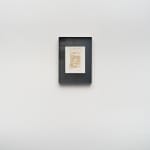Justin Urbach
Frozen Goods II, 2025
Laser engraving on paper, Fabriano Watercolor Paper, oxide crude steel and 35mm analog photography transfer
50 x 70 x 5 cm
19 3/4 x 27 1/2 x 2 inches
19 3/4 x 27 1/2 x 2 inches
Copyright The Artist
Photo: Marjorie Brunet Plaza
Weitere Abbildungen
„Frozen Goods I & II“ (2025) sind Wandarbeiten aus lasergraviertem Papier, die mit Schrauben an Stahlpanelen befestigt sind. Ursprünglich auf analogen Fotografien basierend, werden die Motive durch die Übertragung ins...
„Frozen Goods I & II“ (2025) sind Wandarbeiten aus lasergraviertem Papier, die mit Schrauben an Stahlpanelen befestigt sind. Ursprünglich auf analogen Fotografien basierend, werden die Motive durch die Übertragung ins Digitale und die anschließende Gravur auf das Papier abstrahiert. Der verwendete Laser, als Instrument der modernen Technologie, übersetzt die Körnung des Papiers in ein pixelartiges Raster und etabliert so eine Wechselwirkung zwischen den physischen Eigenschaften des Materials und der digitalen Interpretation. Die ursprünglichen Motive, die in „Frozen Goods I & II“ verarbeitet werden umfassen konkrete Objekte, Orte und abstrakte Formen, die durch die bearbeitete Technik einer radikalen Abstraktion unterzogen werden. Der Übergang von Bildobjekten in das faserige Papier verleiht den Arbeiten eine neue Materialität und macht es selbst zum Speichermedium. Dieser transformative Prozess verweist ebenso auf den fortwährenden Zustand der Veränderung aller Dinge. Schichtung erfährt, die den Raum über seine visuelle Präsenz hinaus erfahrbar macht. Es existieren keine formalen räumlichen Abgrenzungen mehr, weder zwischen Vorder-, Mittel- noch Hintergrund. Das Bild präsentiert sich dem Betrachter als ein schwindelerregendes, desorientierendes Gebiet, in dem vertraute Strukturen und Konventionen ins Nichts aufgelöst sind. Diese formale Entgrenzung lässt die Arbeiten als Rätsel erscheinen, ein Experimentierfeld ohne klare Verortung.
“Frozen Goods I & II” (2025) are wall-based works made of laser-engraved paper, affixed to steel panels with screws. Originally based on analog photographs, the motifs undergo abstraction through their digital translation and subsequent engraving onto paper. The laser, as an instrument of modern technology, transforms the paper’s grain into a pixelated grid, creating an interplay between the physical properties of the material and its digital interpretation. The motifs processed in “Frozen Goods I & II” include concrete objects, places, and abstract forms that, through this technique, are subjected to radical abstraction. The transition of image objects into the fibrous paper lends the works a new materiality, turning the paper itself into a storage medium. This transformative process alludes to the perpetual state of change inherent in all things. The layering within the works extends beyond mere visual presence, making space itself tangible. No formal spatial distinctions remain – foreground, middle ground, and background dissolve. The image presents itself to the viewer as a vertiginous, disorienting terrain where familiar structures and conventions dissipate into nothingness. This formal dissolution renders the works enigmatic, an experimental field without fixed coordinates.
“Frozen Goods I & II” (2025) are wall-based works made of laser-engraved paper, affixed to steel panels with screws. Originally based on analog photographs, the motifs undergo abstraction through their digital translation and subsequent engraving onto paper. The laser, as an instrument of modern technology, transforms the paper’s grain into a pixelated grid, creating an interplay between the physical properties of the material and its digital interpretation. The motifs processed in “Frozen Goods I & II” include concrete objects, places, and abstract forms that, through this technique, are subjected to radical abstraction. The transition of image objects into the fibrous paper lends the works a new materiality, turning the paper itself into a storage medium. This transformative process alludes to the perpetual state of change inherent in all things. The layering within the works extends beyond mere visual presence, making space itself tangible. No formal spatial distinctions remain – foreground, middle ground, and background dissolve. The image presents itself to the viewer as a vertiginous, disorienting terrain where familiar structures and conventions dissipate into nothingness. This formal dissolution renders the works enigmatic, an experimental field without fixed coordinates.











